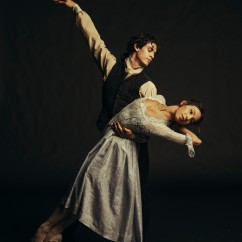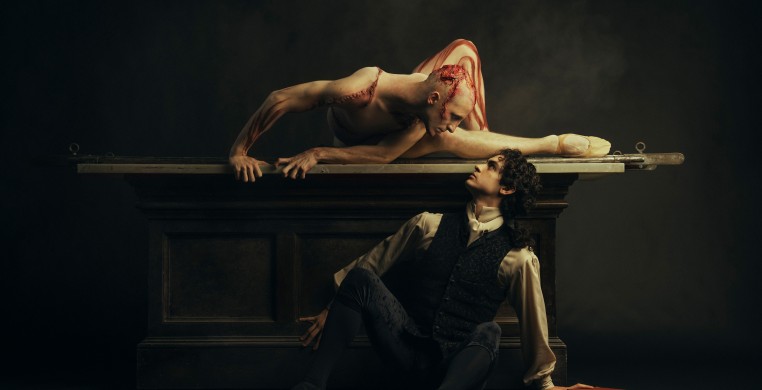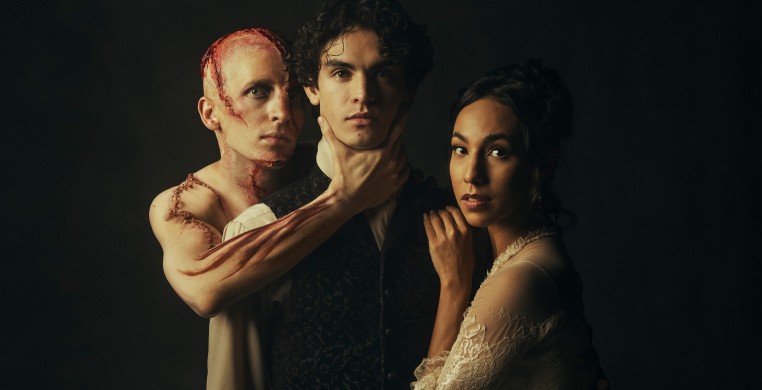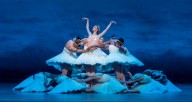Mary Shelley’s groundbreaking science fiction/horror/philosophic novel, “Frankenstein; or, The Modern Prometheus,” has been a tremendous hit ever since its publication in 1818. Despite Shelley’s young age—she was eighteen when she began the work, twenty when it was published.
Existentialism, humanism, isolation and betrayal are themes in the original novel that have led to countless reincarnations over the years.
Various adaptations include the 1931 film starring Boris Karloff, Kenneth Branagh's 1994 film featuring Robert DeNiro as the creature, and skits on Saturday Night Live. “What do you think about Congress cutting the budgets of key federal agencies, Frankenstein?” “…Fire…BAD!”
One of the most recent versions is a ballet choreographed by the late Liam Scarlett that premiered in 2016, a co-production between The Royal Ballet and San Francisco Ballet with an original score by Lowell Liebermann and production design by artist John Macfarlane.
On October 12, Joffrey Ballet Chicago begins the first of ten performances at the Lyric Opera House. The official video trailer—yes, ballets have trailers—promises a moody and macabre experience closer to Shelley’s vision than the bolt-necked, fire-hating monstrosity that has become prominent in popular culture.
“Frankenstein” is not the name of the creature (who remains nameless) but that of its father/creator, Victor Frankenstein, played by a rotating cast of dancers (José Pablo Castro Cuevas/ Alberto Velazquez/ Dylan Gutierrez). Victor is a young man from Geneva, Switzerland, and a “natural philosopher” (re: a scientist before the development of modern science) especially gifted at chemistry, mathematics and anatomy.
Like Zeus withholding fire from man, death appears to mankind shrouded in a veil, its secrets guessed at but never revealed. Not for Victor, whose genius pierces that veil and challenges the laws of nature. Victor recalls that “After days and nights of incredible labour and fatigue, I succeeded in discovering the cause of generation and life; nay, more, I became myself capable of bestowing animation upon lifeless matter.”
The result is the creature, (Joffrey dancers Jonathan Dole/ Hyuma Kiyosawa/ Stefan Goncalvez), described in the book as a “being of a gigantic stature… eight feet in height and proportionally large” but with the compassionate mind of a man, cast out by his creator and feared and loathed by all who lay eyes upon his hideous appearance.
SeeChicagoDance spoke with veteran dancer Laura Morera, who played the original “Elizabeth,” Victor’s adopted sister/love interest, in the show’s premiere. She described what sets this “Frankenstein” apart.
Set in the 18th century, the novel portrays Victor as a moody intellectual and Elizabeth as a distressed damsel from a bourgeois family; in this version, the characters come off as a little less posh. Nevertheless, there are elements of upper-class pedigree in their characterization. “That’s shown in the movement,” said Morera, “in the way they walk and the way they hold themselves. For dancers our speech is in our movement. If you’re playing someone posh or pomp, everything is more elevated. Everything is more raised. But compared to the character of Madam Moritz (Christine Rocas/ Lucia Connolly) who looks after the family and shows little emotion, Victor and Elizabeth are trying to break away from that in a way that is upper-class but is more emotional, very human and engaging.”
The creature is another matter entirely. Bald, pale and covered in red scars from head to toe, he’s born on a slab in a laboratory. At first, he is akin to a newborn child, unable to stand and frightened of everything, but that doesn’t last for long.
“The creature in Liam’s “Frankenstein” is portrayed as childish, vulnerable and seeking the love of his creator and a sense of acceptance in the world,” said Morera. “There’s a real sense of vulnerability; but also there’s the anger that pushes through and a physicality that he can’t control.” You can see the creature lurking around the family scenes in Act 2, a voyeur learning the language of the movement from this family, of which he longs to be a part.
The first time we see the creature move unencumbered is during a solo in Act 2 following a pas de deux between Victor and Elizabeth. The solo captures two emotions, that of childish wonder and deep despair. “It starts with his movement being lyrical and soft,” said Morera. “He forgets his own appearance and imagines himself as part of this family. There are moments when he cradles his face with his palm, then reaches out toward the house longingly.”
But Morera says that the sense of belonging is short-lived. “While reaching, he looks at his own hands and suddenly realizes his inner conflict of ‘who could love me, I’m so ugly?’”
 José Pablo Castro Cuevas (Victor) and Amanda Assucena (Elizabeth); Photo by Todd Rosenberg
José Pablo Castro Cuevas (Victor) and Amanda Assucena (Elizabeth); Photo by Todd Rosenberg
The role of Elizabeth, alternately played by Amanda Assucena, Victoria Jaiani, and Gayeon Jung, is portrayed in the novel as a background character until the final chapters but is featured more prominently in the ballet.
“The role expanded for two reasons,” said Morera. “Artistically, Liam felt that love was at the core of the work. He wanted to create this connection between Elizabeth and Victor, so she is prominent throughout the entire ballet. But honestly, I think he wanted to create a roll for me! He wanted to make these wonderful pas de deux and recreate her as the pillar of good. She’s a well-spoken and beautiful soul who is not passive or weak, whose strength comes from her relationship with Victor and who sees how their love changes after he returns from creating the creature.”
As the ballet progresses, the rejection of his creator and everyone he encounters emboldens him and directs him towards acts of violence.
In Shelley’s novel, all the killings are done off the page, with lifeless bodies found after the fact or through exposition by the creature. (Contrary to the pop culture movie monster, in the book he can say more than a few clumsy words and speaks eloquently).
Scarlett did not shy away from these heinous acts, but instead depicts murder real time, particularly in the last scene where the creature kills Elizabeth. “The creature and Elizabeth have a brutal pas de deux,” said Moreno. “It’s quite visceral and incredible! Because it’s so vicious, we want the dancers to be safe. It’s about how we shape the dancers’ bodies, their dynamics and timing, to create the full effect.”
“We’ve never been scared of showing brutality and a different side of human nature within the art form of dance,” said Morera. “It’s actually one of my favorite moments!”
The original score matches the eerie and morose tone of the action on stage. No stranger to dark-sounding music, composer Lowell Liebermann worked closely with Scarlett during the creation of the work, adding a few bars here or altering a phrase there to match the vision of the choreographer.
While the novel describes several lush landscapes—the snow-covered alpine mountains surrounding Geneva, seas made of ice, trips down the Rhine River—due to technical constraints the ballet is centered around more domestic settings that still promise a grandiose atmosphere.
Beginning in the sprawling Frankenstein manor, the scenery shifts from an extravagant ballroom to a pub in the town of Ingolstadt where Victor goes to pursue his studies. Most recognizable to the “Frankenstein” property is Victor’s laboratory, with all the wires, bulbs and medical equipment and morbid accoutrements one would expect in the lab of a mad scientist.

Designer John Macfarlane is a master of his craft. Besides designing the sets and costumes to be period specific, he also painted the lush backgrounds by hand. For scenes surrounded by a forest of trees, the stage is lifted in the back to give a textured sense of vastness. “It’s all just slightly ‘off,’” said Morera describing the sense of foreboding doom in Macfarlane’s designs. “It’s not just a beautiful place where everyone is happy. As we get to Act 2 and Act 3, you get a feeling that something is not quite right.”
“The music, designs and dance are all connected to create the experience,” said Morera. “Liam was in a true collaboration with the people that he worked with. With Lowell and John, after thousands of conversations, they had one aim and one vision. It’s really important and quite rare!”
Another misconception about the creature is that fire is his weakness. (Fire…BAD!) In Shelley’s novel it’s the opposite. The creature uses fire as a tool to elicit comfort, take revenge and ultimately find peace. When asked about the symbolism of fire in this production of “Frankenstein,” Morera is tight-lipped, not wanting to spoil the finale, an obfuscation that only fuels the imagination.
Often lauded as the first work of science fiction, Mary Shelley’s “Frankenstein” is at its heart a philosophical text. Victor is far from virtuous. The creature, though a vicious murderer, is a pathetic being whose plight elicits profound empathy.
The overlying theme is about humankind’s vast potential and how we use it to create or destroy. Drawing on the book’s subtitle and humanity’s history of war, maybe it wasn’t a good idea for Prometheus to bring us fire from Mount Olympus.
“You won’t leave the ballet thinking ‘Oh, poor Victor’ and ‘the creature is awful,” said Morera. “It’s very human. No one is born bad. No one is born a killer. What are the things that drive one towards a certain path and how does one struggle with that? It’s that inner conflict that we see in Liam’s “Frankenstein.”
“Frankenstein” is presented by the Joffrey Ballet from Oct. 12 – 22 at the Lyric Opera House, 20 N. Wacker Dr. Single tickets start at $36 and are available for purchase at Lyric Opera Box Office, by telephone at 312.386.8905, or online a Joffrey.org.


